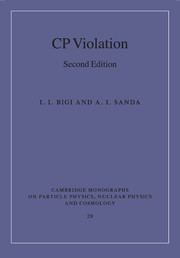Book contents
- Frontmatter
- Contents
- Preface to the second edition
- Preface to the first edition
- Part I Basics of CP violation
- Part II Theory and experiments
- Part III Looking beyond the Standard Model
- 16 Quest for CP violation in the neutrino sector
- 17 Possible corrections to the KM ansatz: right-handed currents and non-minimal Higgs dynamics
- 18 CP violation without non-perturbative dynamics – top quarks and charged leptons
- 19 SUSY-providing shelter for Higgs dynamics
- 20 Minimal flavour violation and extra dimensions
- 21 Baryogenesis in the universe
- Part IV Summary
- References
- Index
20 - Minimal flavour violation and extra dimensions
Published online by Cambridge University Press: 10 March 2010
- Frontmatter
- Contents
- Preface to the second edition
- Preface to the first edition
- Part I Basics of CP violation
- Part II Theory and experiments
- Part III Looking beyond the Standard Model
- 16 Quest for CP violation in the neutrino sector
- 17 Possible corrections to the KM ansatz: right-handed currents and non-minimal Higgs dynamics
- 18 CP violation without non-perturbative dynamics – top quarks and charged leptons
- 19 SUSY-providing shelter for Higgs dynamics
- 20 Minimal flavour violation and extra dimensions
- 21 Baryogenesis in the universe
- Part IV Summary
- References
- Index
Summary
A host of mostly theoretical arguments points to the presence of New Physics (beyond the SM Higgs state) at the 1TeV scale. This led to the expectation that experiments at the LHC will find direct evidence for new degrees of freedom. This confidence has been moderated recently for some people by the fact that neither precision measurements of electroweak observables (like the masses of the weak bosons) nor the detailed data on B decays have so far shown any evidence for such New Physics entering there through quantum corrections. One potential conclusion is that the mass scale of the New Physics states – like SUSY quanta – is significantly higher than the 1 TeV scale and might be beyond the reach of the LHC for direct production. In any case, we view it as a challenge to increase our efforts in B studies.
Alternatively one can search for a principle to suppress sufficiently the impact of New Physics on B and K decays, even when the New Physics quanta enter with masses below 1 TeV. In the SUSY framework described in Chapter 19, that amounts to requiring the mass insertion parameters Δij to satisfy the bounds listed in Table 19.2 (and potentially tighter ones in the future) while retaining squark and gluino masses below 1TeV or so. This might be feasible along the lines sketched in Section 19.4.4.
On minimal flavour violation
As discussed in the preceding Chapter minimal SUSY extensions of the SM can be constructed in such a way that no additional sources of CP violation arise.
- Type
- Chapter
- Information
- CP Violation , pp. 436 - 443Publisher: Cambridge University PressPrint publication year: 2009



